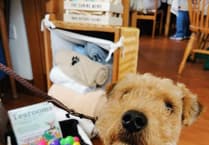In this week’s ManxSPCA column, general manager Juana Warburton introduces us to ‘Cooper’, the loyal rescue dog looking for a loving family...
It’s not hard to see why the doodle, of whatever combination, is irresistible, especially for those looking for a first dog - they’re cute, fluffy and look like teddy bears (lots of them, in fact, are named Teddy or Bear). Popular perception is that their mixed parentage makes them healthier and better-behaved than either of their forebears. They’re also widely thought to be hypoallergenic (although this is not actually the case for every type of doodle), which gives them appeal to a certain sort of pet owner who doesn’t fancy hair on their cushions.
But a recent report from the Royal Veterinary College concluded that doodles are, in fact, no healthier than their pure-bred parents. Cockapoos are three-and-a-half times more likely to have to go to the vet after eating a foreign body than a poodle; labradoodles are more at risk of suffering from allergies and alopecia than poodles, and cavapoos are more likely to throw up all over your house than a King Charles spaniel.
The origins of the doodle are interesting. Thirty years ago the Guide Dogs Association of Australia decided to pair a labrador with a standard poodle as a solution for a blind woman whose husband had allergies. The result, Sultan, was an excellent guide dog and combined the working and social skills of the labrador with the intelligence and agility of the poodle. A canine phenomenon was born.
Talking of canine phenomena, Cooper, who has been in our rescue kennels for some time now, is not a doodle but he is often mistaken for one because of his fluffy good-looks. In fact, he is a four-year-old cocker spaniel but he does share many of the temperament traits that are often observed in cockapoos, particularly when they hit adolescence. They become reactive towards certain other dogs and they constantly test their boundaries, and they need ongoing training.
Cooper doesn’t put a paw wrong when he’s in our kennels. He likes the daily routine, he enjoys his food, and he happily potters around the exercise fields with our volunteers. The problems arise when he goes into a home – he’s been out ‘on trial’ with several different families and, after just a few days, he has been brought back by them all.
Why? Cooper’s most difficult behaviour issue is his need to guard his environment. Lots of dogs can be possessive over a food bowl, a bone or a favourite toy but Cooper takes this to the extreme and starts to guard rooms and staircases. He becomes aggressive if someone breaches his ‘threshold’ but, thankfully, he hasn’t bitten anyone.
His new family will need to be experienced dog owners who understand Cooper’s needs, and who are prepared to work on his behaviour issues over a long period of time. Resource guarding can be overcome with patience - for example, by teaching commands such as ‘drop it’ and rewarding positive reactions; and by creating a ‘go to’ place where the dog feels safe and is rewarded when they enter it (crates are often used for this purpose).
Cooper also has lots of positive and endearing personality traits – he loves long walks and, true to his spaniel heritage, he likes nothing more than getting wet either in the rain, which makes his coat go curly or, best of all, in a full-blown swim in a plantation pond. He’s good fun, affectionate and full of character, and we’re confident that the right home is out there for him ... he just needs to find it.
.jpg?trim=72,0,72,0&width=752&height=501&crop=752:501)

.jpeg?width=209&height=140&crop=209:145,smart&quality=75)
.JPG?width=209&height=140&crop=209:145,smart&quality=75)
